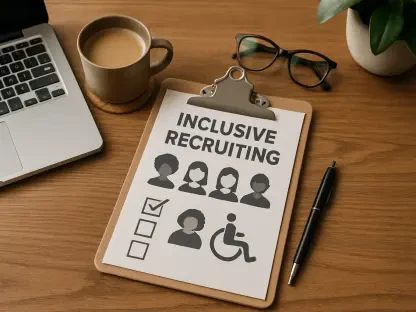In an era where workplace equity is increasingly under the spotlight, pay transparency has emerged as a critical mechanism for fostering fairness, with Colorado setting a groundbreaking precedent through its Equal Pay for Equal Work Act, effective since 2021. As the first state in the United States to require salary range disclosures in job postings, Colorado aimed to tackle the enduring gender pay gap by ensuring that compensation for similar roles remains equitable across genders and other protected categories. Yet, the impact of such legislation extends well beyond this initial objective, influencing hiring practices, reshaping employee expectations, and sparking cultural shifts in how compensation is discussed. This exploration delves into the broader implications of pay transparency, examining its achievements in narrowing wage disparities, the systemic challenges it cannot fully address alone, and its transformative role in modern employment dynamics. Through a detailed analysis, the significance of transparency as both a tool and a catalyst for deeper change becomes evident.
Unpacking the Gender Pay Gap Challenge
Despite progressive measures like Colorado’s transparency law, the gender pay gap persists as a complex and deeply entrenched issue in the workforce. Recent data from the Bureau of Labor Statistics reveals that full-time female workers in Colorado earned just 82 cents for every dollar earned by men in 2023, marking a slight improvement from previous years. A more nuanced study by economist Max Tejera, which accounts for variables such as education, race, and industry, shows a more promising shift, with the adjusted gap narrowing to 86 cents on the dollar by mid-2025. These figures indicate that while transparency laws are contributing to measurable progress, the pace of change remains slow. The stubborn nature of the gap suggests that simply making salary information public is not enough to dismantle disparities rooted in historical and economic inequities, pointing to the need for a more comprehensive approach to achieve true parity.
Beyond the numbers, the gender pay gap is influenced by a web of societal factors that transparency alone cannot unravel. Structural barriers, such as occupational segregation where women are often funneled into lower-paying fields, play a significant role in perpetuating wage differences. Additionally, biases in how pay is determined and the lingering effects of traditional gender roles further complicate the landscape. For instance, women are more likely to face career interruptions or reduced hours due to family responsibilities, which impacts long-term earning potential. Experts argue that while laws mandating salary disclosures help highlight these disparities, they do not address the underlying cultural and systemic issues driving the gap. This realization underscores that transparency must be viewed as a starting point rather than a complete solution, prompting a broader conversation about the multifaceted nature of wage inequity.
Systemic Obstacles to Wage Equity
Pay transparency, while a powerful tool, falls short of addressing the deep-seated systemic barriers that sustain gender wage disparities. One significant issue is the “motherhood penalty,” where women often experience a drop in earnings after having children due to career breaks or shifts to part-time roles. In contrast, men are more likely to occupy high-paying positions that demand long hours, a phenomenon referred to as the “greedy jobs problem.” These dynamics reveal how societal expectations around caregiving and work-life balance disproportionately affect women’s financial outcomes. Experts like Louise Myrland from the Women’s Foundation of Colorado emphasize that without targeted interventions, such as accessible childcare and paid family leave, transparency laws can only partially mitigate the gap. Addressing these root causes requires a shift in both policy and workplace norms to create an environment where career progression is not hindered by gender-specific burdens.
Another critical barrier lies in the persistent issue of occupational segregation and implicit biases that influence compensation decisions. Women remain underrepresented in high-earning sectors like technology and finance, often due to historical exclusion and lack of early career opportunities. Even within the same industries, subtle biases in hiring, promotions, and pay negotiations can result in unequal outcomes. Transparency laws help by making salary disparities visible, allowing organizations to identify and correct unexplained differences. However, they do not inherently change the cultural attitudes or structural pipelines that funnel men and women into different career paths. To complement transparency, initiatives like mentorship programs, diversity training, and policies promoting flexible work arrangements are essential. These measures aim to level the playing field by tackling the systemic inequities that lie beyond the scope of salary disclosure mandates.
Revolutionizing HR and Recruitment Strategies
Pay transparency laws have introduced a transformative shift in HR practices, particularly in how recruitment and compensation are approached. By mandating salary ranges in job postings, Colorado’s legislation empowers candidates to make informed decisions, targeting roles that align with their financial expectations. This clarity benefits employers as well, as it reduces the number of mismatched applications and streamlines the hiring process. Emilie Aries, CEO of a Denver-based career services company, notes that transparency eliminates the traditional negotiation dance where candidates might undervalue themselves out of fear of overasking. Instead, a more equitable starting point for salary discussions is established, minimizing the risk of unintended pay disparities from the outset. This practical change not only fosters fairness but also enhances efficiency in matching talent with opportunities.
The impact of transparency on HR extends to fostering a culture of trust and accountability within organizations. When salary ranges are disclosed, companies are prompted to review and justify their compensation structures, often leading to internal audits to address unexplained gaps. This process can serve as a catalyst for broader equity initiatives, encouraging firms to adopt consistent pay scales and transparent promotion criteria. Furthermore, candidates armed with salary information are better positioned to advocate for fair treatment, reducing the likelihood of long-term wage inequities taking root. As transparency becomes a norm, it reshapes expectations around fairness in the workplace, pushing HR departments to prioritize equity not just as a legal requirement but as a core component of organizational integrity. This shift signals a profound change in how talent is attracted and retained in a competitive market.
Cultural Evolution in Pay Discussions
A significant cultural transformation is occurring around how compensation is discussed, driven largely by younger generations entering the workforce. Unlike previous cohorts who often viewed salary conversations as taboo, today’s workers increasingly see transparency as a fundamental aspect of workplace fairness. Kelly Voss, a leader in rewards advisory at a global consulting firm, highlights that openness about pay is becoming a key part of a company’s employee value proposition. This shift reflects a growing demand for accountability, where disparities based on gender, race, or other factors are met with scrutiny and resistance. As younger employees push for candid discussions, companies face mounting pressure to align their practices with these evolving expectations, suggesting a future where pay equity could gain momentum through cultural change rather than legislation alone.
This generational shift also influences how transparency is perceived as a marker of organizational values. Companies that embrace open compensation practices often find themselves better positioned to attract top talent, especially among millennials and Gen Z workers who prioritize fairness and authenticity. Publicly addressing pay gaps or committing to regular equity audits can enhance a firm’s reputation, signaling a commitment to justice beyond mere compliance. Moreover, as social media and online platforms amplify discussions about workplace experiences, employees are more empowered to share and compare salary information, further normalizing transparency. This cultural evolution indicates that the push for equity is not just a top-down policy effort but a grassroots movement, driven by a workforce that views open dialogue as essential to dismantling systemic disparities over time.
Corporate Responsibility as a Market Edge
Transparency in pay is increasingly seen as a strategic advantage for companies aiming to stand out in a competitive labor market. Organizations that proactively address wage disparities and publicize their efforts often gain a reputational boost, appealing to both current and prospective employees. For instance, firms that commit to regular pay audits and transparent compensation frameworks demonstrate a dedication to fairness, which can be a powerful differentiator. This trend shows that transparency is not merely a compliance issue but a branding opportunity, as businesses leverage their equity initiatives to build trust and loyalty among stakeholders. In a tight labor market, such accountability can tip the scales in attracting diverse, high-caliber talent seeking workplaces aligned with their values.
Beyond attraction, corporate responsibility in pay practices also fosters internal cohesion and productivity. When employees perceive their compensation as fair and transparent, morale and engagement often improve, reducing turnover and associated costs. Transparency laws serve as a catalyst for companies to scrutinize their pay structures, uncovering and rectifying discrepancies that might otherwise go unnoticed. This proactive stance not only mitigates legal risks but also positions firms as leaders in workplace equity, setting a standard for others to follow. As more businesses recognize the link between transparent pay practices and long-term success, the adoption of such policies is likely to grow, reinforcing the idea that equity is not just a moral imperative but a sound business strategy in today’s environment.
Building a Holistic Path to Equity
While pay transparency laws represent a crucial step toward workplace fairness, they are not a standalone solution to the complex issue of wage disparities. Experts and advocates consistently point to the need for complementary policies that address the root causes of inequity, such as the disproportionate caregiving responsibilities often borne by women. Measures like subsidized childcare, paid family leave, and flexible scheduling are vital to support workers in balancing professional and personal demands without sacrificing earning potential. Colorado’s experience with transparency legislation serves as a case study in cautious progress, demonstrating that while salary disclosure can highlight disparities and prompt action, it must be paired with broader societal changes to create lasting impact in narrowing wage gaps across demographics.
Looking ahead, the journey toward full pay equity requires a multi-pronged approach that integrates transparency with systemic reform. Policymakers, employers, and communities must collaborate to dismantle barriers like occupational segregation and bias in career advancement, ensuring that opportunities for high-earning roles are accessible to all. Additionally, fostering a workplace culture that values open dialogue about compensation can sustain momentum for change, as seen in the attitudes of younger generations. The narrative from Colorado’s pioneering law reflects a blend of optimism and realism—transparency has moved the needle, but comprehensive solutions are essential to address the full spectrum of challenges. By building on these foundations, the path to equity can be paved with both legislative innovation and cultural transformation, aiming for a future where fair pay is a universal standard.









